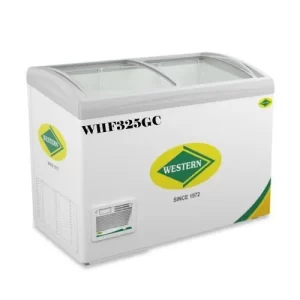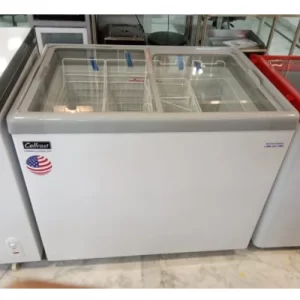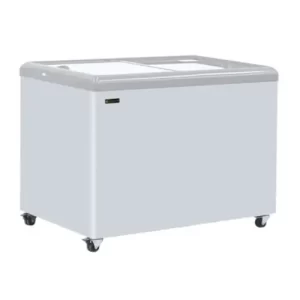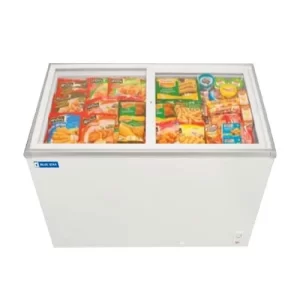Glass Top Freezers
-
₹29,760.00
-
₹25,200.00
-
₹26,160.00
-
₹31,200.00
-
₹26,160.00
-
₹27,000.00
Glass Top Freezers: The Perfect Solution for Display and Storage
Introduction to Glass Top Freezers
In the world of food storage and display, glass top freezers have become an essential piece of equipment for businesses ranging from grocery stores to ice cream shops. These freezers not only offer superior functionality but also enhance product visibility, making them an invaluable asset for retailers. This comprehensive guide explores the features, benefits, and various applications of glass top freezers, along with essential maintenance tips and a detailed FAQ section to help you make an informed purchasing decision.
What is a Glass Top Freezer?
A glass top freezer is a commercial-grade refrigeration unit designed with a transparent glass lid that provides visibility into the contents stored within. These freezers are typically used in retail environments to display frozen products while keeping them at optimal storage temperatures. They come in various sizes and styles, accommodating a wide range of products, including frozen foods, ice cream, and beverages.
Key Components of a Glass Top Freezer
- Glass Lid: The most distinguishing feature, the glass lid, allows customers to see the contents without opening the freezer, maintaining temperature and reducing energy consumption.
- Insulated Body: A well-insulated body helps retain cold temperatures, ensuring that products remain frozen and minimizing energy loss.
- Cooling System: Most glass top freezers are equipped with either a static or forced air cooling system, providing consistent temperatures throughout the unit.
- Adjustable Shelves: Many models come with adjustable shelving or storage bins, allowing for flexible organization of various product sizes.
- Digital Temperature Control: This feature enables precise temperature settings, ensuring that the products are stored at the ideal freezing temperatures.
- Casters: Many glass top freezers come with wheels, making them easy to move for cleaning or repositioning within the store.
How Does a Glass Top Freezer Work?
The operation of a glass top freezer is fairly straightforward. The unit uses a refrigeration cycle to maintain low temperatures and preserve food quality:
- Cooling Mechanism: The cooling system compresses refrigerant, which absorbs heat from the interior of the freezer. This process lowers the temperature inside the unit.
- Temperature Regulation: The digital thermostat allows users to set and monitor the internal temperature. The compressor activates as needed to maintain the desired temperature.
- Airflow Management: Depending on the model, forced air cooling systems circulate cold air throughout the unit to ensure uniform temperature distribution, while static systems rely on natural convection.
- Visibility and Access: The glass lid allows customers to view products without needing to open the freezer, which helps to maintain the internal temperature while encouraging impulse purchases.
Benefits of Glass Top Freezers
1. Enhanced Product Visibility
One of the most significant advantages of glass top freezers is their ability to display products attractively. The transparent lid allows customers to see what’s inside, increasing the likelihood of impulse buys.
2. Energy Efficiency
Glass top freezers are designed to minimize energy consumption. The insulated body and glass lid help maintain temperature, reducing the need for excessive cooling cycles and ultimately saving on electricity bills.
3. Versatility
These freezers are suitable for various products, including frozen meals, ice cream, meats, and beverages. Their adaptable design makes them an excellent choice for different retail settings.
4. User-Friendly Design
With features like adjustable shelves and digital controls, glass top freezers are easy to use. Retailers can customize the interior layout to accommodate different product sizes and types.
5. Easy Maintenance
Glass top freezers are generally easy to clean and maintain. The smooth surfaces and removable shelving make routine cleaning straightforward, ensuring that the unit remains hygienic and presentable.
6. Space-Saving Design
Many models are designed to fit into smaller retail spaces while maximizing storage capacity. Their low-profile design allows for easy integration into existing store layouts.
Applications of Glass Top Freezers
1. Grocery Stores
Grocery stores utilize glass top freezers to display frozen food items such as vegetables, pizzas, and desserts, making them easily accessible to customers.
2. Ice Cream Shops
Ice cream shops benefit from glass top freezers that showcase various flavors and toppings, enticing customers with a visual presentation of their offerings.
3. Convenience Stores
Convenience stores use glass top freezers to store and display frozen snacks and meals, providing quick options for customers on the go.
4. Restaurants and Cafés
Restaurants can use these freezers to store ingredients like frozen meats, seafood, or desserts while keeping them visible for quick access during food preparation.
5. Bakeries
Bakeries often use glass top freezers to showcase frozen pastries, cakes, or bread, allowing customers to see the options available.
6. Catering Services
Catering businesses can store and display frozen items for events, ensuring that clients can easily view available selections.
Choosing the Right Glass Top Freezer
When selecting a glass top freezer, consider the following factors:
1. Size and Capacity
Evaluate your space and determine how much storage capacity you need. Consider the dimensions of the freezer to ensure it fits comfortably within your retail environment.
2. Cooling System
Choose between static and forced air cooling systems based on your needs. Forced air systems generally provide better temperature consistency, especially in busy retail settings.
3. Energy Efficiency Rating
Look for models with high energy efficiency ratings to minimize operational costs. Energy-efficient units may have additional features like LED lighting and improved insulation.
4. Temperature Range
Ensure the freezer can reach the required temperature range for your products. Some items, like ice cream, may require lower temperatures than standard frozen foods.
5. Design and Aesthetics
Consider the design and aesthetics of the freezer, ensuring it complements your store’s overall look. Some models offer customizable features or finishes to match your branding.
6. Budget
Set a budget and compare different models within that range. Keep in mind that while cheaper options may save you money upfront, investing in higher-quality models can result in long-term savings.
Maintenance Tips for Glass Top Freezers
To ensure the longevity and optimal performance of your glass top freezer, follow these maintenance tips:
1. Regular Cleaning
Clean the interior and exterior surfaces regularly to prevent buildup of dust, dirt, and food particles. Use a mild detergent and warm water for cleaning, and avoid harsh chemicals that can damage surfaces.
2. Check Door Seals
Inspect the rubber seals on the glass lid to ensure they are intact. Damaged seals can lead to air leaks, causing the unit to work harder to maintain temperature.
3. Monitor Temperature
Regularly check the internal temperature using a thermometer. Ensure it remains within the recommended range for the products stored inside.
4. Defrost as Needed
If your freezer is not frost-free, check for ice buildup and defrost when necessary. Excessive frost can reduce efficiency and storage capacity.
5. Inspect Cooling System
Periodically check the cooling system components for any signs of wear or malfunction. This includes the compressor, evaporator, and condenser coils.
6. Schedule Professional Servicing
Consider scheduling professional maintenance at least once a year to ensure all components are functioning correctly and to address any potential issues before they become serious problems.
FAQ About Glass Top Freezers
1. What are the main advantages of a glass top freezer?
Glass top freezers offer enhanced product visibility, energy efficiency, versatile storage options, and user-friendly designs. They are also easy to maintain and fit well in various retail environments.
2. How do I choose the right size glass top freezer for my business?
Consider your available space and the volume of products you need to store. Measure the area where you plan to place the freezer, and choose a model that fits those dimensions while providing adequate storage capacity.
3. Are glass top freezers energy-efficient?
Yes, many modern glass top freezers are designed with energy efficiency in mind. Look for models with high energy efficiency ratings to minimize electricity costs.
4. Can I use a glass top freezer for ice cream storage?
Absolutely! Glass top freezers are ideal for ice cream storage, especially those with adjustable temperature settings that can reach lower temperatures.
5. How often should I clean my glass top freezer?
Regular cleaning is essential. Aim to clean the interior and exterior surfaces at least once a week, and conduct a thorough cleaning monthly to maintain hygiene.
6. What should I do if my glass top freezer is not cooling properly?
If your freezer is not maintaining the proper temperature, check the following:
- Ensure the door seals are intact.
- Inspect the cooling system for any visible issues.
- Monitor the thermostat settings. If the problem persists, consult a professional technician.
7. Do glass top freezers require a lot of maintenance?
While they do require some maintenance, glass top freezers are generally easy to care for. Regular cleaning and temperature checks are the main maintenance tasks.
8. Can I stack products in a glass top freezer?
While you can stack some products, it’s essential to ensure that air can circulate properly. Avoid overloading the freezer, as this can block airflow and affect cooling efficiency.
9. Are there any specific foods I should avoid storing in a glass top freezer?
Glass top freezers are suitable for most frozen foods, but avoid storing items that require specific temperature controls unless the freezer can accommodate those requirements.
10. How long does it take for a glass top freezer to reach the desired temperature?
The time required to reach the desired temperature can vary based on the model and current conditions. Generally, it may take a few hours for a new unit to stabilize after being plugged in.





